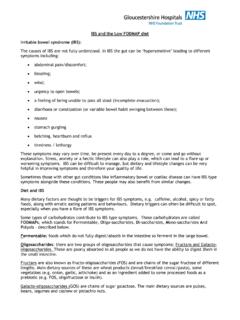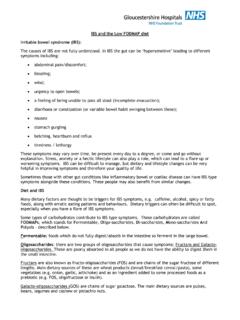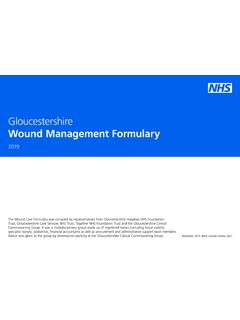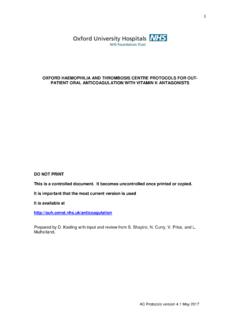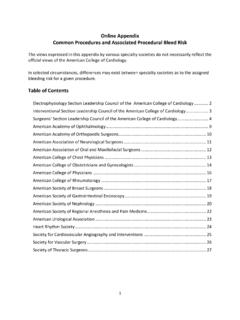Transcription of Guidelines for the Management of Warfarin During Invasive ...
1 Page 1 of 7 Guidelines for the Management of Warfarin During Invasive Procedures These Guidelines provide recommendations for patients on long-term Warfarin (or other vitamin K antagonists) who require an elective procedure for which an INR < is preferred. Patients on these oral anticoagulants requiring emergency procedures may require rapid anticoagulant reversal and should be discussed with a clinical haematologist on a case-by case basis. Certain procedures may be performed without interruption of anticoagulation (with INR < ) including minor dental, ophthalmological and dermatological surgery, diagnostic angiography and Invasive cardiology procedures, and diagnostic endoscopies (including ultrasound), biliary or pancreatic stenting.
2 Refer to the relevant specialist or departmental Guidelines . Management of perioperative anticoagulation varies according to the balance between thrombosis risk (baseline risk plus additional thrombotic risk from the procedure) and bleeding risk (baseline risk of patient on anticoagulant plus additional risk from the procedure). Reintroduction of prophylactic or therapeutic anticoagulation following an Invasive procedure must be based on the assessment of surgical site bleeding risk: a period without any anticoagulation may be required to avoid excessive or critical site bleeding.
3 Procedures with a very high operative bleeding risk may follow these protocols but post-procedural anticoagulation may need to be individualized and should be discussed between the responsible surgeon and haematologist. It is important that the risks of the procedure are discussed with the patient and a plan agreed upon. A senior member of the team is best placed to evaluate the risks, discuss them and formulate a plan. The templates in this document provide a way for the outcomes of these discussions to be clearly documented for all members of the team involved in the patient s care.
4 Procedures under spinal or epidural anaesthesia require specific consideration: refer to GHNHSFT Policy Reference A395 Anticoagulation and Spinal/Epidural Anaesthesia . Neuraxial procedures including catheter insertion or removal should not be performed if INR , within 12 hours of prophylactic dose dalteparin or with 24 hours of treatment dose dalteparin (>5,000iu). Perform a patient risk assessment using table 1 then select from the following four template protocols.
5 Protocol D is intended for patients receiving high intensity anticoagulation (usually with a target INR ). These templates may require modification for patients considered to have a very high bleeding risk, patients with renal impairment or to accommodate neuraxial procedures as recommended above. Prescribing information for low molecular weight heparin is contained in the Appendix on the final page of this document. Page 2 of 7 Table 1: Thrombotic Risk Groups High Moderate Low Chronic atrial fibrillation CHADS2 score CHF 1 point Hypertension 1 point Age >75 1 point Diabetes 1 point Prior Stoke or TIA 2 points Stroke or TIA within 6 months rheumatic valvular heart disease CHADS2 score =5 or 6 CHADS2 score =3 or 4 (Use Template Protocol A*)
6 CHADS2 score 2 + no prior stroke or TIA Mechanical Heart Valves Any mechanical valve + CVA or TIA within 6 months any mechanical mitral valve caged ball or tilting disc aortic valve Bileaflet aortic valve + any additional stroke risk factor: stroke risk factors chronic AF LV dysfunction hypertension age >75 diabetes prior stoke or TIA Bileaflet aortic valve and no other risk factors for stroke Venous Thromboembolism (if VTE within 3 months consider postponing surgery or placing an IVC filter) VTE within 3 months antiphospholipid syndrome (venous or arterial thrombosis) or severe heritable thrombophilia (antithrombin deficiency should be referred to haematology) recurrence of VTE on anticoagulation (target INR ) (protocol D)
7 VTE within 3-12 months VTE on long-term anticoagulant therapy (target INR ) cancer therapy within 6 months or active disease (patients usually on LMWH) (patients with previous VTE not on anticoagulation should follow the thromboprophylaxis protocol) Template Protocol C or D Template Protocol B Template Protocol A *Newly published data suggest this group have low peri- operative thrombotic risk and should be managed using Protocol A. Other indications in Moderate Thrombotic Risk should use Template Protocol B.
8 Therapeutic dose dalteparin =200iu/kg: maximum dose =18,000iu/day Page 3 of 7 Anticoagulant Bridging Protocol for Invasive Procedures and Surgery Protocol A: LOW THROMBOTIC RISK Name: Date of birth: Hospital number: Procedure: Date of Procedure: Surgeon: Anaesthetist: Indication for Anticoagulation: Target INR: Patient Weight kg Current Creatinine umol/L Date Management Day -4 day dd/mm/yy stop Warfarin (last dose given Day -5)
9 No pre- operative anticoagulation required Day -1 day dd/mm/yy if feasible, check INR - and consider Vitamin K 1mg orally if INR Op day day dd/mm/yy check INR on admission providing haemostasis is secure, and at the discretion of the responsible surgeon, start dalteparin 5,000iu subcutaneously once daily 6-8 hours post-operatively Day +1 day dd/mm/yy providing haemostasis is secure restart Warfarin at usual maintenance dose (no loading doses) and give dalteparin 5,000iu subcutaneously daily (6PM) until INR for two consecutive days for procedures under spinal or epidural anaesthesia refer to GHNHSFT Policy Reference A395 Anticoagulation and Spinal/Epidural Anaesthesia check platelet count every 2 days after starting dalteparin to exclude heparin induced thrombocytopenia ensure anticoagulation follow up arranged on discharge from hospital Risks of procedure discussed with patient and above Management plan agreed Authorising Senior Clinician (sign) (print)
10 Position Date therapeutic dose dalteparin =200iu/kg: maximum dose =18,000iu/day Page 4 of 7 Anticoagulant Bridging Protocol for Invasive Procedures and Surgery Protocol B: MODERATE THROMBOTIC RISK Name: Date of birth: Hospital number: Procedure: Date of Procedure: Surgeon: Anaesthetist: Indication for Anticoagulation: Target INR Patient Weight kg Current Creatinine umol/L (creatinine clearance <30ml/min.)




